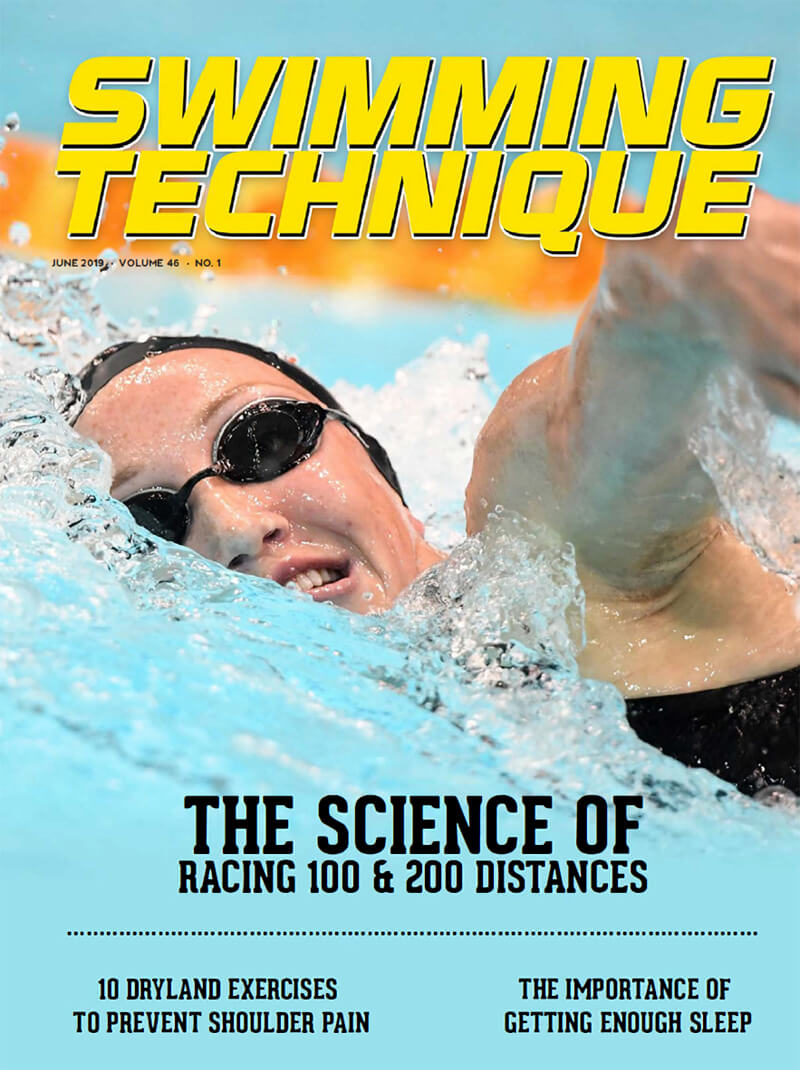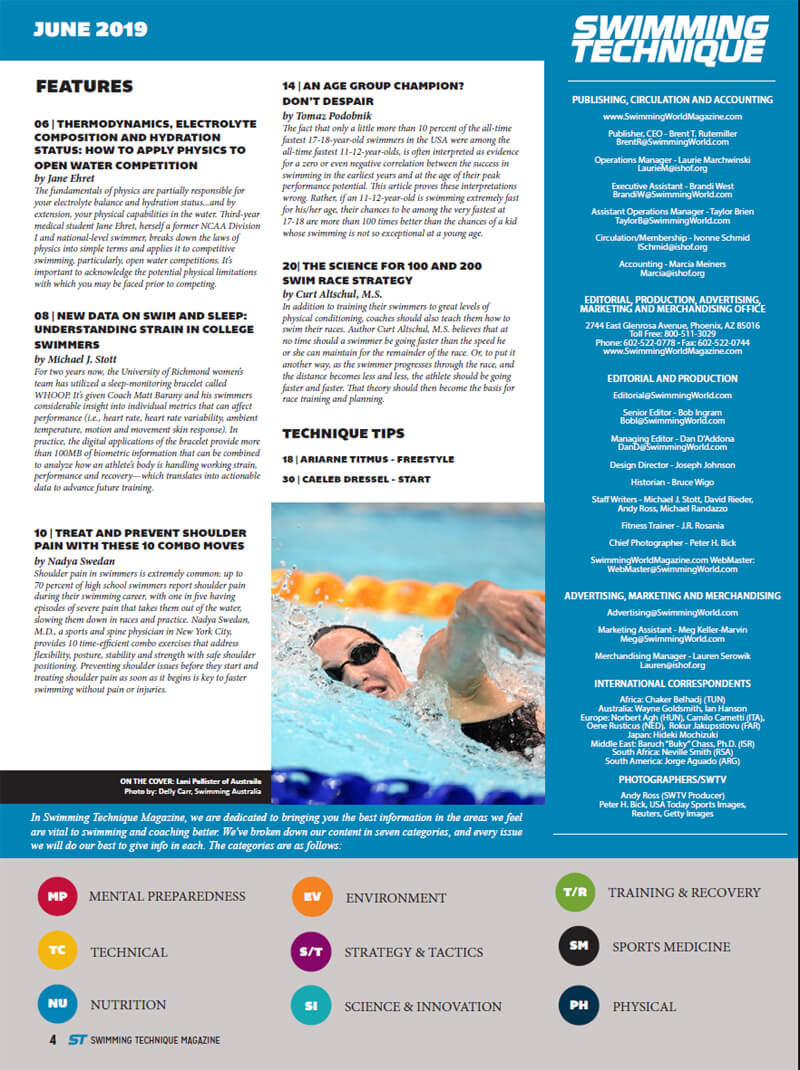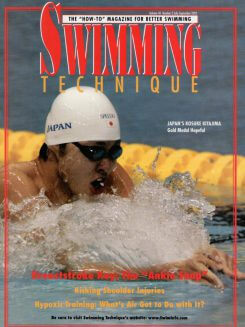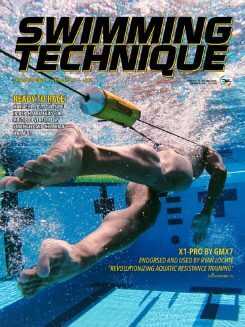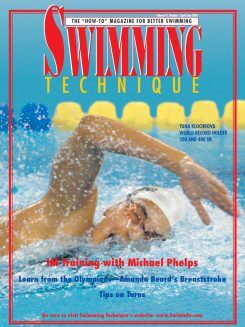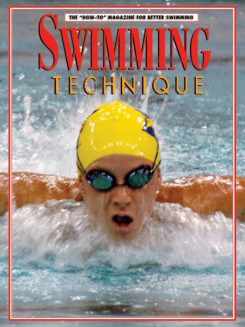Description
Swimming Technique June 2019 Issue
This issue of Swimming Technique features the science of racing strategies for 100 & 200 distances. Also read about thermodynamics, electrolyte composition and hydration status, and applying physics to open water competition. New data on swim and sleep, understanding the strain in college swimmers. Treat and prevent shoulder pain with 10 combo moves. The science of age group swimmers and swim speed development with age. In Technique Tips, Ariarne Titmus and Caeleb Dressel feature.
This issue downloads easily for Total Access Subscribers.
Swimming Technique Feature Stories
06 | THERMODYNAMICS, ELECTROLYTE COMPOSITION AND HYDRATION STATUS: HOW TO APPLY PHYSICS TO OPEN WATER COMPETITION
by Jane Ehret
The fundamentals of physics are partially responsible for your electrolyte balance and hydration status…and by extension, your physical capabilities in the water. Third-year medical student Jane Ehret, herself a former NCAA Division I and national-level swimmer, breaks down the laws of physics into simple terms and applies it to competitive swimming, particularly, open water competitions. It’s important to acknowledge the potential physical limitations with which you may be faced prior to competing.
08 | NEW DATA ON SWIM AND SLEEP: UNDERSTANDING STRAIN IN COLLEGE SWIMMERS
by Michael J. Stott
For two years now, the University of Richmond women’s team has utilized a sleep-monitoring bracelet called WHOOP. It’s given Coach Matt Barany and his swimmers considerable insight into individual metrics that can affect performance (i.e., heart rate, heart rate variability, ambient temperature, motion and movement skin response). In practice, the digital applications of the bracelet provide more than 100MB of biometric information that can be combined to analyze how an athlete’s body is handling working strain, performance and recovery—which translates into actionable data to advance future training.
10 | TREAT AND PREVENT SHOULDER PAIN WITH THESE 10 COMBO MOVES
by Nadya Swedan
Shoulder pain in swimmers is extremely common: up to 70 percent of high school swimmers report shoulder pain during their swimming career, with one in five having episodes of severe pain that takes them out of the water, slowing them down in races and practice. Nadya Swedan, M.D., a sports and spine physician in New York City, provides 10 time-efficient combo exercises that address flexibility, posture, stability and strength with safe shoulder positioning. Preventing shoulder issues before they start and treating shoulder pain as soon as it begins is key to faster swimming without pain or injuries.
14 | AN AGE GROUP CHAMPION? DON’T DESPAIR
by Tomaz Podobnik
The fact that only a little more than 10 percent of the all-time fastest 17-18-year-old swimmers in the USA were among the all-time fastest 11-12-year-olds, is often interpreted as evidence for a zero or even negative correlation between the success in swimming in the earliest years and at the age of their peak performance potential. This article proves these interpretations wrong. Rather, if an 11-12-year-old is swimming extremely fast for his/her age, their chances to be among the very fastest at 17-18 are more than 100 times better than the chances of a kid whose swimming is not so exceptional at a young age.
20| THE SCIENCE FOR 100 AND 200 SWIM RACE STRATEGY
by Curt Altschul, M.S.
In addition to training their swimmers to great levels of physical conditioning, coaches should also teach them how to swim their races. Author Curt Altschul, M.S. believes that at no time should a swimmer be going faster than the speed he or she can maintain for the remainder of the race. Or, to put it another way, as the swimmer progresses through the race, and the distance becomes less and less, the athlete should be going faster and faster. That theory should then become the basis for race training and planning.
TECHNIQUE TIPS
18 | ARIARNE TITMUS – FREESTYLE
30 | CAELEB DRESSEL – START




